Driving safely is of the utmost importance. However, car accidents, traffic violations or car damage can happen to anyone. Many people may record a video of the aftermath of an accident or snap a picture of another vehicle’s license plate. These actions are not always safe and don’t help prove who was at fault for insurance purposes.
Instead, consider the modern dashcam, which records as you drive and instantly captures any accident or damage to your vehicle. With a dashcam, you can capture the identity of the person who hit you to prove you weren’t at fault. Dashcams are a great investment that helps make you a better driver and prevents you from making claims for an accident you didn’t cause. These benefits can also help you avoid getting higher premium rates on your car insurance.
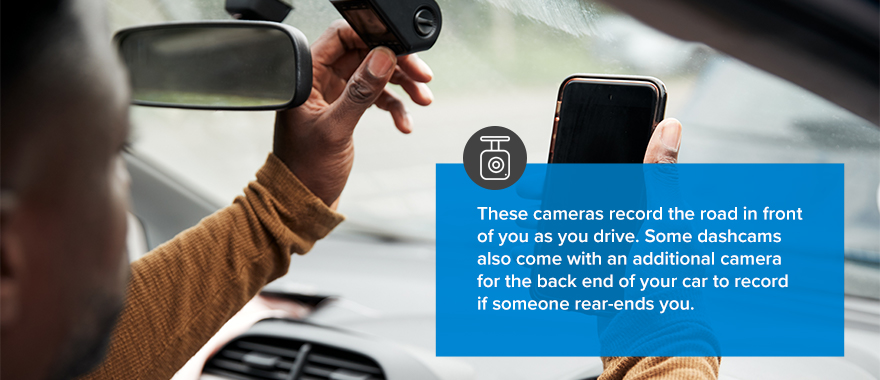
Dashcams are digital cameras you can mount to your vehicle’s windshield or dashboard. These cameras record the road in front of you as you drive. Some dashcams also come with an additional camera for the back end of your car to record if someone rear-ends you. These cameras act as a witness to an accident, allowing you to pull up the footage and determine who was at fault.
These cameras record constantly and often record over old footage if you run out of storage. This feature ensures you will be covered at any moment should you experience a collision. You can feel confident you will have proof of a vehicle hitting you or other damage to your car if you cannot take pictures of it for insurance.
Dashcams usually have a cable, but they’re available in wireless or battery-powered versions. Dashcams are equipped with different SD cards and varying recording resolutions for higher-quality options to easily capture license plates and faces. These cameras start recording as soon as you start your car — or when you manually turn them on, depending on the model you get — and can sense increases in acceleration.
Dashcams also ensure any impacts and collisions will not be recorded over due to lack of storage because these are placed in a separate folder. Installing a dashcam can range from simple to complicated depending on the model. You can also hardwire your dashcam to your car to record while your vehicle is parked. Adding this extra protection will capture any motion, collision or damage to your vehicle even when it’s not moving.
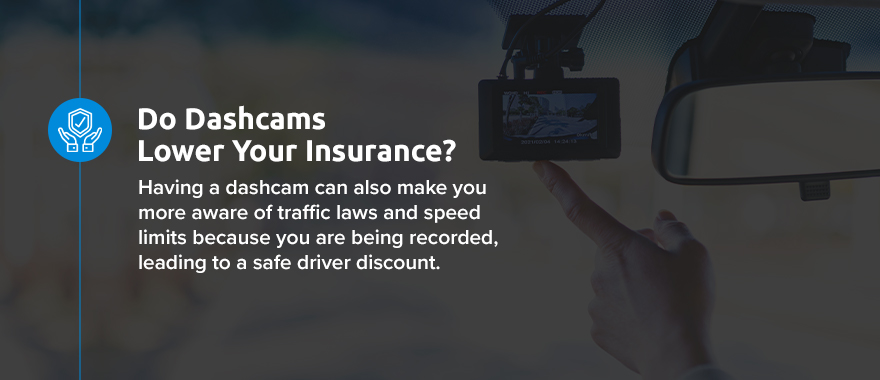
Though having a dashcam alone will give you a discount, it can definitely help you keep your insurance premiums low. Dashcams come with many benefits that can make you a safer and more cautious driver, which will help prevent your premiums from increasing in the future.
Having a dashcam can also make you more aware of traffic laws and speed limits because you are being recorded, leading to a safe driver discount. Ultimately, it doesn’t hurt to get a dashcam so that you can have proof of any wrongful claims, traffic violations, accidents or speeding tickets. The footage will help you settle any claims with your insurance, proving you are a cautious driver.
Dashcams can also be placed on the inside of your car to show you don’t use your cellphone while driving, which can also lead to a safe driver discount.
You may have seen plenty of dashcam videos on the internet or social media. These videos usually consist of dashcams catching pedestrians throwing themselves on cars to appear hit or capturing highway collisions. Dashcams are often used for more important reasons — to provide evidence of who is at fault in an accident and capture footage of dangerous drivers.
Dashcams can also assist in a lawsuit if someone falsely accuses you of hitting them or tries to steal your car. There are several other reasons why a dashcam might be beneficial for you, including the following:
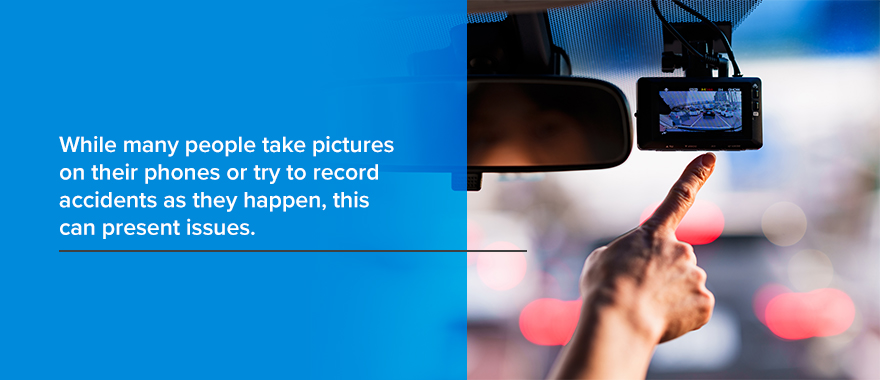
The primary function of a dashcam is to provide a reliable, impartial record of your accident for authorities and insurance companies. While many people take pictures on their phones or try to record accidents as they happen, this can present issues. Firstly, using your phone while driving or operating a vehicle is considered a liability and very unsafe. Secondly, when taking pictures, your photos may appear blurry or be dismissed as unreliable.
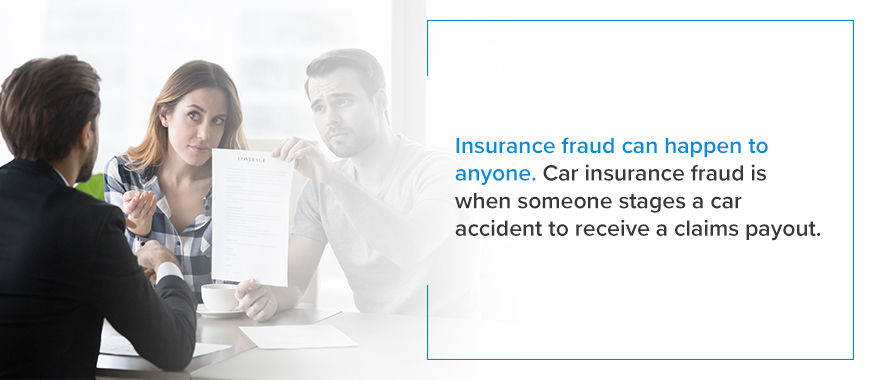
Insurance fraud can happen to anyone. Car insurance fraud is when someone stages a car accident to receive a claims payout. Unfortunately, this can cost you thousands of dollars and raise your insurance premiums. Suppose you believe someone may have involved you in auto insurance fraud through a car accident. In that case, you can give your dashcam footage to law enforcement authorities, the insurance company involved or the fraud unit.
The footage of your accident can help you save money and clear your case or claim with your insurance company.
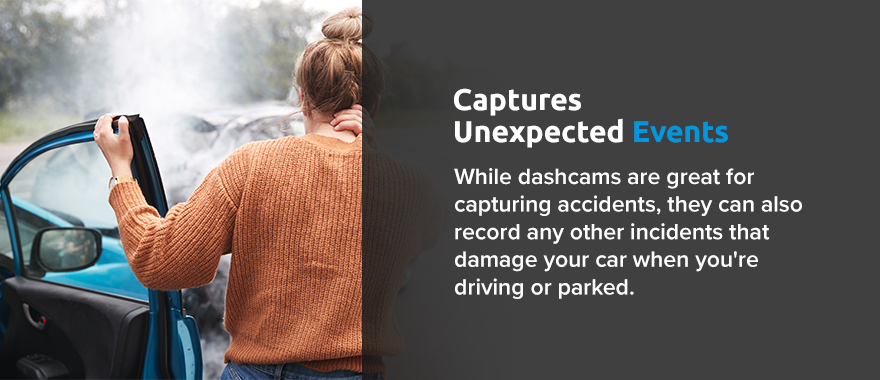
While dashcams are great for capturing accidents, they can also record any other incidents that damage your car when you’re driving or parked. For instance, falling tree limbs, debris, theft or vandalism can cause thousands of dollars in unexpected damages. You may also face wildlife impacts or animals trying to quickly cross the road. Though these damages are usually covered under comprehensive insurance policies, having the dashcam footage will certainly help speed up this process.
The footage will also help you sort through any issues with your claim with the insurance company by showing the reason for your claim. This can help you get the car repairs you need without too much hassle.
Some dashcams have a motion sensor that turns on even when you are not in the vehicle. This feature acts as a security camera if someone tries to steal your car or take something from inside it. Easily visible dashcams may deter someone from trying to break into your car as they know they are most likely being recorded.
However, if a person still decides to vandalize or steal from your car, your dashcam footage will upload to your computer or mobile device and show you their identity. Without a dashcam, it would be difficult to provide evidence of a crime without a witness, especially if objects are stolen. Dashcam footage could save you thousands of dollars in fixing car damage or replacing stolen items if you don’t have a comprehensive insurance policy.
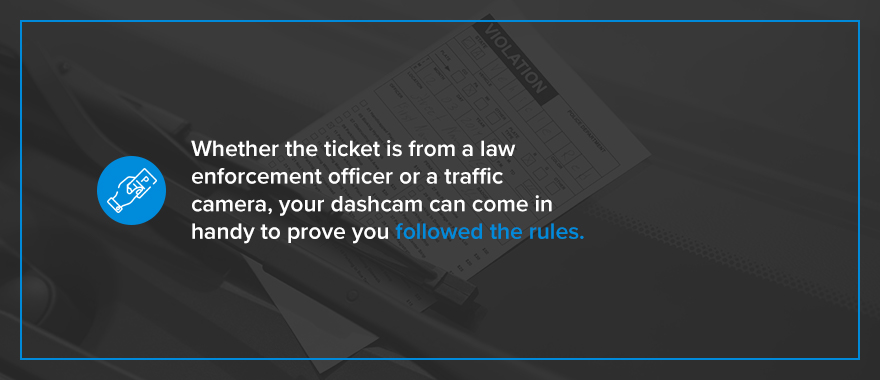
Unfortunately, there are some instances where you may be wrongfully issued a traffic violation or speeding ticket. Whether the ticket is from a law enforcement officer or a traffic camera, your dashcam can come in handy to prove you followed the rules. You can offer your dashcam footage to the officer before they write you a ticket to prove you didn’t commit the violation.
If the officer won’t watch the footage or your ticket is from a traffic camera, you can take your footage to court with you and contest the ticket there. This evidence can help you get out of the ticket and ensure there are no points on your driving record, which lead to higher auto insurance rates.
Having a teen driver can be stressful. Teens are usually more likely to make riskier decisions and don’t have much experience driving, which is why you will often see a high premium for even the most basic coverage. Having a dashcam can give you peace of mind while your teen is driving on the road and encourage them to always drive safely because they are being monitored.
Dashcams will let you see if your teen is following traffic laws and speed limits, and you can use them to tell your teen how to improve their skills. If your teen is driving recklessly, you can intervene before they get a ticket or get into an accident that leads to higher insurance premiums. A good teen driver will also be eligible for a car insurance discount if they maintain good grades and participate in a driving program.
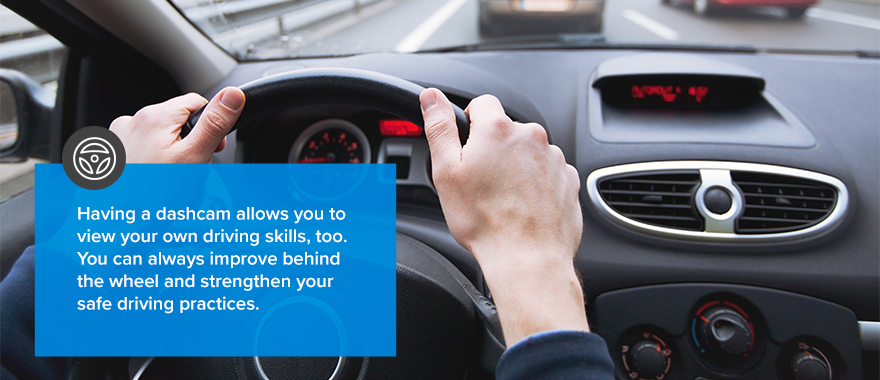
Having a dashcam allows you to view your own driving skills, too. You can always improve behind the wheel and strengthen your safe driving practices. For example, you may not even realize that you tend to switch lanes without using your turn signal or brake too hard at stop signs. Using a dashcam will help you stay aware of your surroundings and help you avoid close calls or bad car accidents.
Being a better driver without any traffic tickets or car accidents on your record for a long period will often result in you getting or keeping a safe driver discount, reducing your premiums.
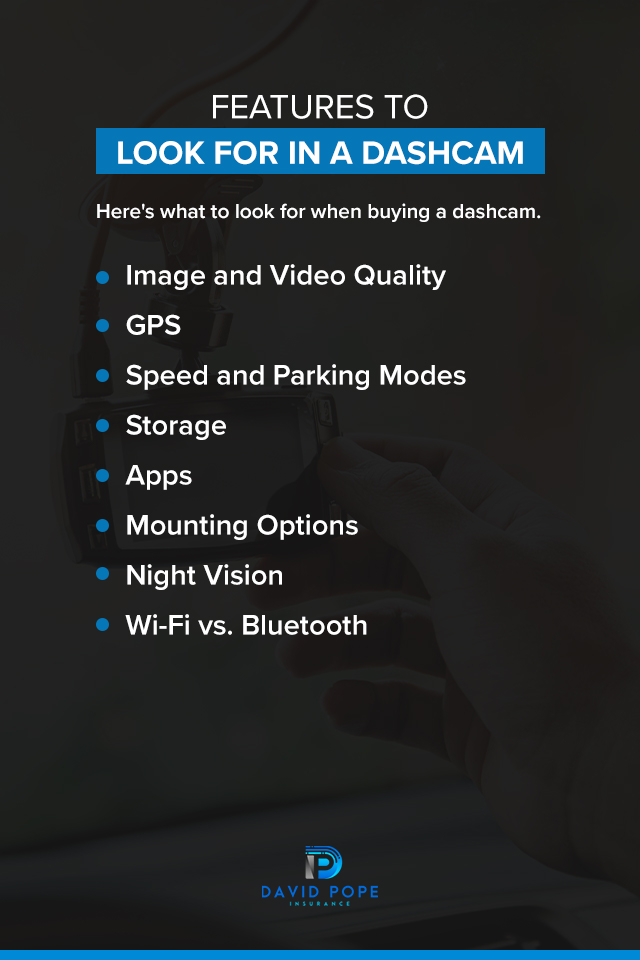
Dashcams are available in various models, sizes, styles, capabilities and price points. There are also many dashcam features you may not have considered. Here’s what to look for when buying a dashcam.
The dashcam’s picture and video quality are the most important features. A camera that takes blurry, choppy videos won’t help you prove you weren’t at fault in an accident or capture the identity of the person who tried to steal your car. Your camera’s resolution determines the number of pixels in an image, and a higher pixel count gives you a clearer view. The frames per second (FPS) is the rate of how many frames are being recorded.
The higher the FPS, the smoother and less grainy your videos will be. Your field of view (FOV) feature is how wide your dashcam can see. This feature will determine if your camera only views your windshield or if it can stretch further past your side-view mirrors. Research these options and see which camera has the best range for you. Just remember that the higher video and image quality, the more expensive your dashcam will likely be.
GPS tracking is great if you own a business with fleet drivers. This feature will track and monitor the vehicle’s location and the driver’s speed. GPS tracking is also beneficial for everyday use, as some dashcams with this feature can track your vehicle if it has been stolen.
Dashcams are a great witness when you’re driving, but some of them turn off when your car is parked. Dashcams with motion detection and impact sensors will turn on even when your car is in park and can detect events like hit-and-runs. Dashcams with this feature will record until the motion or impact is no longer detected or the camera runs out of battery.
Some dashcams can also detect your speed, which is helpful if you get into an accident or receive a wrongful speeding ticket. Though these features are normally part of more pricey cameras, they may be worthwhile as they can help protect your assets.
Dashcams that constantly record or hold a lot of footage need accommodating storage. If you drive often, you’ll probably want a dashcam with a larger storage system or external devices that can store footage. More storage means your footage won’t be recorded over as often, which can accidentally delete useful evidence. Hard drives can increase your storage, and you can also manually delete footage to free up more space, but this may be a hassle for you.
Consider getting a dashcam with plenty of high-storage SD card options or features that connect to your phone for easy management.
Some dashcams come with pairing apps that allow you to upload the footage straight to your phone or computer. These apps almost always need an internet connection but are valuable for instant transfers. This feature also prevents any useful footage from being recorded over as you can easily manage it. With apps, you can make copies of your footage if you or someone else accidentally deletes the original when viewing.
Installing your dashcam properly is important to help it remain in place and record steady videos. There are a few mounting options for your dashcam on your dashboard or windshield.
If you drive primarily at night, dashcams with night vision can be a great option for you. Some cameras have trouble recording without proper lighting, so if you get into an accident late at night, your dashcam footage might not help you. Night vision allows you to clearly see how an accident unfolded, even in pitch-black settings. This feature is especially beneficial for truck drivers or those who deliver shipments throughout the night.
While some dashcams come with Bluetooth options, transferring your data is often much slower without an internet connection. Wireless internet connectivity will let you manage your storage, adjust recording settings or view and sort through your footage on your smartphone or another device. With Wi-Fi, you may not even need an SD card, as your footage can upload straight to the cloud or an app on your mobile device.
Dashcams are like any technological device — their price range is quite broad. While the camera you choose will depend on your budget and the type of features you are looking for, many options can fit your needs. You may want one with all the features mentioned above, or one that simply records with good video quality may be fine for you.
If you’re looking for the best quality in a dashcam, consider these options:
Try these models for the best dashcam pricing:
Here are some frequently asked questions about dashcams that you may have before purchasing one for your vehicle.
As with any purchase, you should debate the pros and cons of getting a dashcam to see if it’s worth it. The positive aspects may outweigh the price point of your chosen camera. With this device, you can have more peace of mind knowing any accident will be recorded, which can help you avoid making insurance claims. Dashcam footage might also save you money on insurance from potential tickets or liability claims.
Your needs and how often you use your car are also factors to consider. If you are a ride-share driver or deliver food daily in your own car, a dashcam would make sense because you are driving constantly. However, if you work from home, live in a walkable city or only use your car for a few things, you may not find it necessary to buy one. Additionally, if you are a careful, defensive driver, dashcams are definitely worth it for you.
You can also use a dashcam to help an inexperienced driver save money on insurance as they improve their driving skills. Plus, if you have previously gotten into accidents that were not your fault, dashcams can help you prove you are not responsible for certain damages in any future accidents.
Dashcam footage is usually admissible in court depending on the case and jurisdiction. The footage can be useful to help solve any issue regarding an accident or provide evidence for how an accident happened. However, if you are recording audio or video inside your car, your passengers must be notified and consent to being recorded. Otherwise, your camera should be turned off. Additionally, dashcam footage will be harder to use in a court case if you have recorded private property.
While it is possible to set up and use a GoPro as a dashcam, it might not be the best idea. GoPros may even be more expensive than dashcams, as they can run for hundreds of dollars without any of a dashcam’s functions. Here are a few more reasons why GoPros can lead to issues:
You should always mount your dashcam on your windshield facing the road in the front or back of your vehicle. However, placement depends on how many dashcams you are looking to purchase. One dashcam is perfectly adequate to capture your car’s movement if you are impacted from the side or rear. But if you have a large truck, van or commercial vehicle, you may want to invest in multiple dashcams to cover all areas of your car.
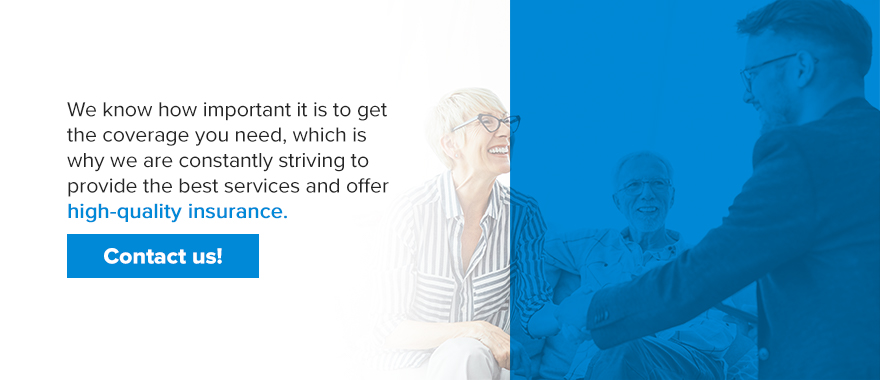
Purchasing a dashcam is a great idea because it helps you become a better driver. As a safe driver, you can receive discounts from insurance firms like David Pope Insurance Services, LLC. We are also proud to offer defensive driver and teen driver discounts. At David Pope Insurance, we shop around to bring you flexible quotes, low rates and affordable premiums for your car insurance. Our auto insurance policies cover a wide range of drivers, including those with less than perfect driving records, new drivers and teen drivers.
We know how important it is to get the coverage you need, which is why we are constantly striving to provide the best services and offer high-quality insurance. Our family-owned business is committed to serving anyone we can. Our local, experienced agents can connect you with the right policy for your needs. Request a quote today to see how we can find the right plan for you.